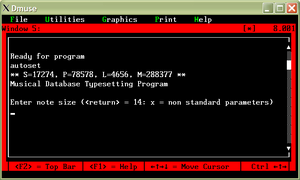Dmuse: Score printing
Starting from Stage2 MuseData files
When starting from MuseData files, the data must be converted into i-files which are then converted into page files. To convert the MuseData files into i-files, you must use the autoset program.
Directory preparation
Before running autoset, you should create several sub-directories in the main working directory. The main working directory for a work will contain a stage2 directory which contains all of the MuseData files for all parts of all movements for the work. The autoset program expects a certain directory structure to exists, so if you try to run the program without the proper directory structures created, the program will stop with an error message.
Before starting autoset, you should make sure that there is a sub-directory in the same directory as stage2 which is named outputs. Within outputs, you must create an arbitrarily named sub-directory into which the output files from autoset will be stored. Typical sub-project directory names might be score when creating a full score, or parts when preparing instrumental parts. And finally, within the sub-project directory, you must create an additional sub-directory called i-files.
Within the i-files directory, autoset will automatically create movement sub-directories which mirror the directory structure that is found within the stage2 sub-directory in the main working directory for the work.
This directory structure can be prepared from within dmuse by using the file manager which is opened with the F4 function key.
Running autoset

To start autoset go to an empty window, such as #5 by typing Keypad 5. If window 5 is not empty, but the contents does not need to be saved, press Home to get to the top of the window, and then press Shft+Keypad -.
To start autoset, first press Shft+Keypad * to start the zbex interpreter. Once the zbex interpreter is running, the string "[*]" will appear on the top right border of the dmuse window. If this mark does not appear, then you will have to edit the Dmuse INIT file to enable the zbex interpreter. The zbex interpreter will print the text "Ready for program". Type the name of the program to run, which in this case is autoset, and then press Return. Zbex will then start running autoset. The figure on the right demonstrates what should happen in Dmuse at this initial stage when starting autoset.
Music size
The first question that autoset asks is:
Enter note size (<return> = 14: x = non standard parameters)
This question sets the font size of the music. Font size 14 means that there are 14 pixels between staff lines (in 300 DPI). Font size 14 is the standard font size for scores (you can press return to use that default size). The smallest possible size should be 6. Parts are usually typeset in size 21. Not all font sizes are available.
Compression factor
The next question which is asked is:
Compression factor (<return> = none)
You should probably press return for the default compression factor of 100. For denser music, use a smaller value, such as 90. For greater spacing between notes, try something like 110. Good results are usually in the 92-96 range. Sometimes 85-87 might be needed. This value is typically used to get the last page to contain a full page of music.
Source file location
The third question that autoset asks is where are the MuseData files located:
Autoset performs the first step of the music typesetting process. Autoset takes stage2 source files as input and produces non-page specific intermediate files. Since the stage2 directory contains source files for a variety of uses, you need to specify the group (i.e. sound, score, skore, parts, short or data) that you want autoset to work on. Enter the source library and group name now. Source library?
At this point it is useful to have the resident file manager point to the main working directory or one of its parent directories. For example if the musedata files are stored in /usr/local/apps/musedata/baroque/corelli/chry/trio/op1n12, it might be useful to set the file manager to be looking at the directory /usr/local/apps/musedata/baroque/corelli/chry/trio. If you set the file manager to point to this directory, then you can answer the above question like this:
op1n12/stage2/01
if you want to generate a score for the first movement.